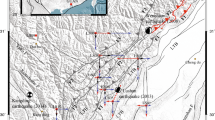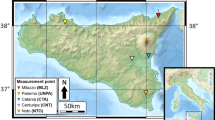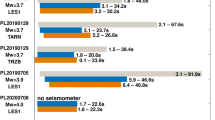Abstract
THE Global Positioning System (GPS) is a powerful tool for detecting crustal deformation1; for example, the technique has been used to detect plate boundary movements in California2. Here we report observations of crustal deformation associated with seismic swarm and sea-floor volcanic activity off the east coast of the Izu Peninsula, Japan, in July 1989, using a fixed-point GPS network. These measurements have enabled us to capture some rarely observed features of seismic and volcanic activity. We have, for the first time, used GPS fixed-point measurements to follow the evolution with time of the crustal movements; such measurements provide a continuous uninterrupted record of deformation. Our observations were supported by independent data from other sources, thus providing further evidence for the utility of the GPS.
This is a preview of subscription content, access via your institution
Access options
Subscription info for Japanese customers
We have a dedicated website for our Japanese customers. Please go to natureasia.com to subscribe to this journal.
Buy this article
- Purchase on SpringerLink
- Instant access to full article PDF
Prices may be subject to local taxes which are calculated during checkout
Similar content being viewed by others
References
Prescott, W. H. et al. Science 244, 1337–1339 (1989).
Davis, J. L. et al. J. geophys. Res. 94, 13635–13650 (1989).
Ishida, M. Proc. Earthquake Prediction Res. Symp. 51–60 (1987). (in Japanese).
Geographical Survey Institute Rep. Coordinating Com. Earthquake Prediction 41, 283–302 (1989) (in Japanese).
Japan Meteorological Agency, Rep. Coordinating Com. Earthquake Prediction 41, 227–242 (1989) (in Japanese).
Swinbanks, D. Nature 340, 175 (1989).
Shimada, S. et al. J. geod. Soc. Japan 35, 85–95 (1989).
Okada, Y. Nature 312, 500–501 (1984).
Okada, Y. & Yamamoto, E. Prog. Abstr. Seismol. Soc. Japan 2, 118 (1989) (in Japanese).
Author information
Authors and Affiliations
Rights and permissions
About this article
Cite this article
Shimada, S., Fujinawa, Y., Sekiguchi, S. et al. Detection of a volcanic fracture opening in Japan using Global Positioning System measurements. Nature 343, 631–633 (1990). https://doi.org/10.1038/343631a0
Received:
Accepted:
Issue Date:
DOI: https://doi.org/10.1038/343631a0
This article is cited by
-
MOWLAS: NIED observation network for earthquake, tsunami and volcano
Earth, Planets and Space (2020)
-
A Comprehensive Study of Gridding Methods for GPS Horizontal Velocity Fields
Pure and Applied Geophysics (2017)
-
A decade of GEONET: 1994–2003 —The continuous GPS observation in Japan and its impact on earthquake studies—
Earth, Planets and Space (2014)
-
The impact of atmospheric mountain lee waves on systematic geodetic errors observed using the Global Positioning System
Earth, Planets and Space (2014)
-
High-rate precise point positioning (PPP) to measure seismic wave motions: an experimental comparison of GPS PPP with inertial measurement units
Journal of Geodesy (2013)



